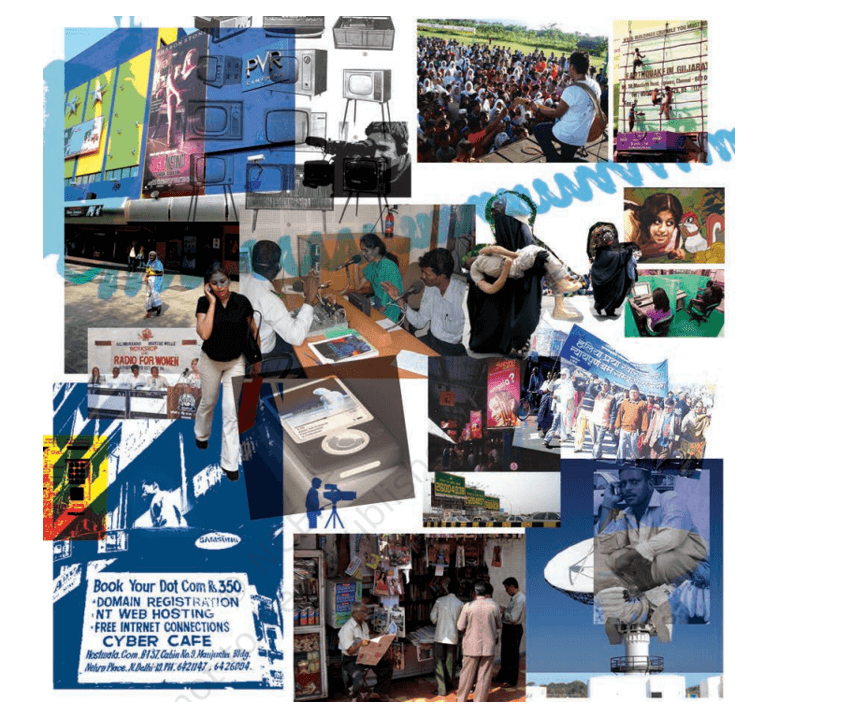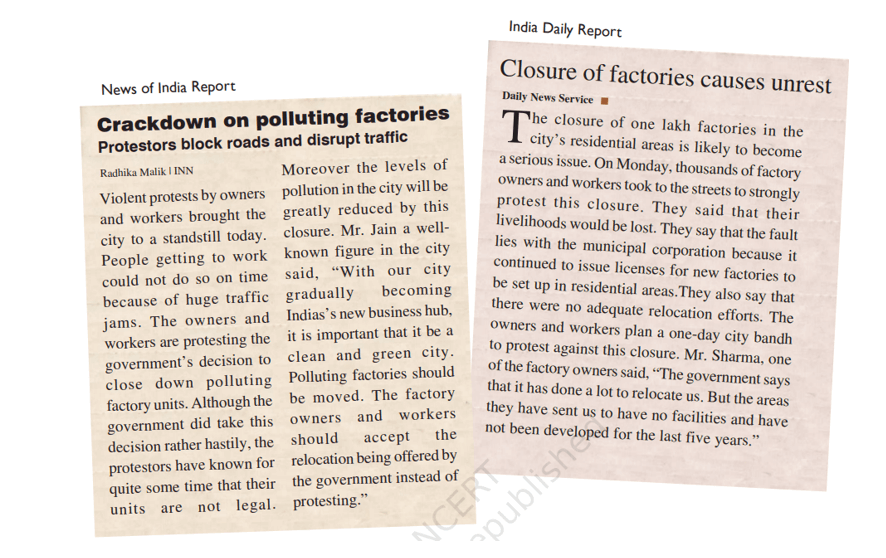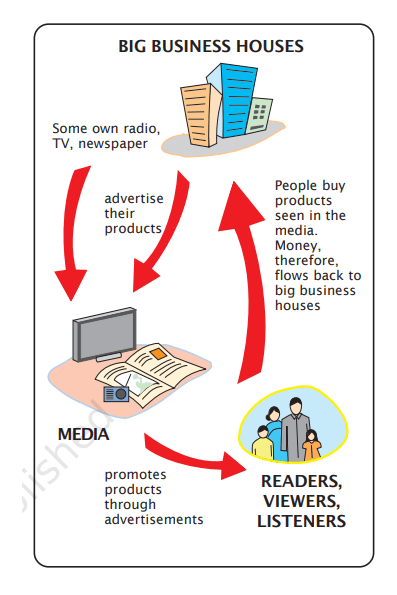Civics - Class 7
Social and Political Life II
Chapter 6: Understanding Media
Intext Questions:
Question 1 : Look at the collage on the left and list six various kinds of media that you see.

Answer:The six various kinds of media are as under :
- Television
- Radio
- Internet
- Mobile
- newspaper
- Magazines
Question 2 : Ask older members of your family about what they used to listen to on the radio when there was no TV around. Find out from them when the first TV came to your area. When was cable TV introduced?
Answer:The older member of my family says that they used to listen to news and songs on the radio when there was no TV in my locality. They say that the first TV came to my area in the 1980 s. Cable TV was introduced in the 1990 s in my area.
Question 3 : How many people in your neighbourhood use the internet?
Answer:There are around 50 people in my neighbourhood, who use the internet.
Question 4 : List three things that you know about some other parts of the world from watching television?
Answer:
- The headquarters of the United Nations situated in New York, USA.
- Hiding Park is in England.
- Capital punishment, i.e., hangs to death of Saddam Husain in Baghdad (Iraq).
Question 5 : Can you list three different products that are advertised during your favourite TV programme?
Answer: My favourite TV programme is NEWS. I see many products advertised during the news report as LUX soap, Close-up toothpaste, and Tide washing soap.
Question 6 : Take a newspaper and count the number of an advertisement on it. Some people say that newspapers have too many advertisements. Do you think this is true and why?
Answer:I counted 145 advertisements in the ‘Hindustan Times’. Yes, Newspapers have too many advertisements. The reason is that every newspaper is published by a private publishing house as a business to earn a profit. So, unless there will be more advertisement, they will not earn a profit.
Question 7 : Are the stories given in the two newspapers similar? And if not, why not? What, in your view, are the similarities and the differences?

Answer:The stories in these two newspapers are
not similar in totality.
The stories are not similar because neither of the two newspapers has given a balanced news
report. It means they are not as independent as media should be for giving a balanced
news-report for the success of democracy.
Similarities: Similarities in my view are
that both
the newspapers have reported on the same topic i.e., ‘closure of factories’. In both the
newspapers, the protest by the factories’ owners and workers is highlighted.
Differences :The news-report in the ‘News of
India’
has pointed out that protestors were disrupting traffic and polluting the city continuously.
But, the story in the India Daily has related the protest with the livelihoods of the
workers and factory owners because of the closure of the factories.
Question 8 : If you read the story in the News of India, what would you think about the issue
Answer:If I read the story in the News of India, I would think that the news story is not balanced about the issue covered. I would have thought that the mistake is of industries owners and government has taken right decision.
Question 9 : Do you think it is important to know both sides of the story? Why?
Answer: Yes, it is important to know both sides of the story. The reason being that the people take action as citizens on the basis of the information the media provides them. So it is very important that this information be balanced, reliable, and unbiased.
Question 10 : Pretend that you are a journalist for a newspaper and write a balanced story from the two news reports.
Answer:
- The closure of one lakh factories in the city’s residential areas led the factory owners and workers together on Monday in the streets and protest the closure.
- The closure of the factories is going to destroy the means of livelihoods of lakhs of owners and workers.
- The government has decided to shift the factories to another area and not close for them forever.
- Because these factories are polluting the city. It has become a major hindrance in making the city clean and green to develop it as India’s new business center.
- But Mr. Sharma, one of the factory owners said, “The government says that it has done a lot to relocate us. But the areas , The government is willing to send us to, have no adequate facilities and not been developed for the last five years.” So it is a serious issue both for providing livelihood to the factory owners and the workers and to make the city clean and green.
- The government should take the necessary steps to provide adequate facilities for relocation. And the factory owners and workers should accept the relocation offered instead of protesting.
Question 11 : What is the consequence of the media ‘setting the agenda! by reporting on the Fashion Week’rather than the slum demolitions?
Answer: The consequence of the media ‘setting the agenda’ by reporting on the Fashion Week rather than the slum demolitions are the following: Several local groups have started their own media. For example, “Khabar Lahriya’ a fortnightly newspaper is started by eight Dalit women in the Chitrakoot district, in Uttar Pradesh. It is in ‘Bundeli’, a local language. Several people from NGOs have started using community radio to advise farmers about the use of seeds and fertilizers, and the price of different crops. Some local poor people started documentary films with cheap video cameras on real-life conditions of poor communities.
Question 12 : Can you think of an issue that does not seem important to you because it is never featured in the media?
Answer:No. I cannot think of an issue that does not seem important to me because it is never featured in the media. Each and every issue is important from its own point of view but media highlights only those issues which fulfill their interest at large.
Exercises
Question 1 : In what ways does the media play an important role in a democracy?
Answer:Role of media played in democracy:
- It is the backbone or the fourth pillar of a democracy which makes us aware of social, political and economical activities.
- Provides news and discussing events taking place in the country and the world.
- It gives people the information about how government works.
- It also give information about the election related news and results.
- It raises the issues or problems related to the common people in front of politicians.
- It also acts as a reminder for the politicians or ministers about their promises.
Question 2 : Can you give this diagram a title? What do you understand about the link between media and big business from this diagram?

Answer:The title given to this diagram is "Media and Business house money cycle". From this diagram, we understood that there is a cyclic flow of money between media and big business.
- Media shows news of interest to the people on radio, TV and newspaper.
- Big business houses advertise their products through media to attract people.
- Media show these advertisements by taking some charges and makes profit.
- People buy these products of the big business and thus the cost and advertisements along with some profit returns to them.
Question 3 : You have read about the ways in which the media ‘sets the agenda’. What kind of effect does this have in a democracy? Provide two examples to support your point of view.
Answer:Effect of this agenda in a democracy:
- It influences the thoughts, feelings and actions of the people.
- It brings attention of the people to the various issues of the people.
- Somehow, it has influence in our lives and in shaping our thoughts and thus sets the agenda. Two examples in support:
(i) The media drew our attention to alarming levels of pesticides in cola drinks. They published reports that indicated the high level of pesticides and thus made us aware of the need to regularly monitor these colas according to international quality and safety standards.
(ii) It published the news of the mass numbers of suicide committed by the farmers which leads to large scale movement and people support and thus forced the government to look further on this issues.